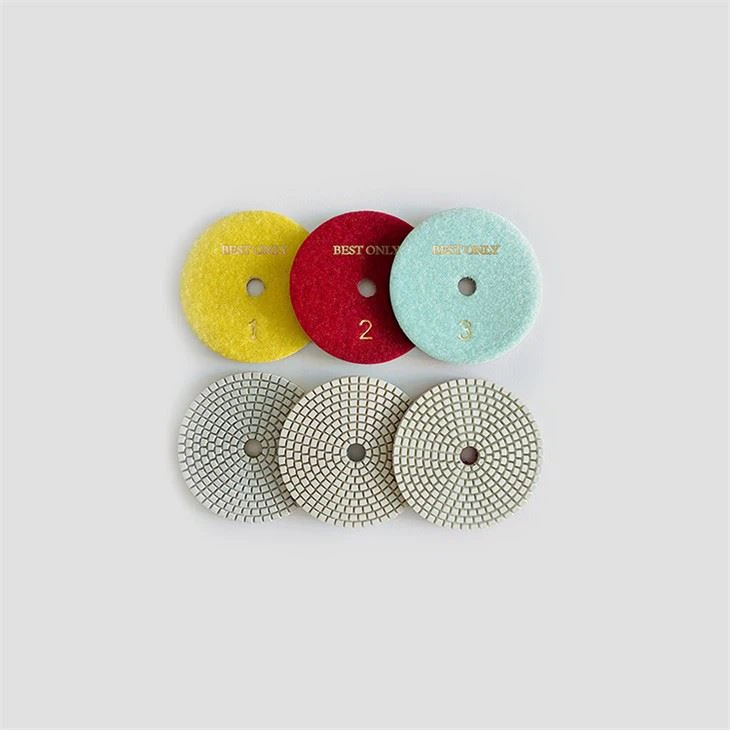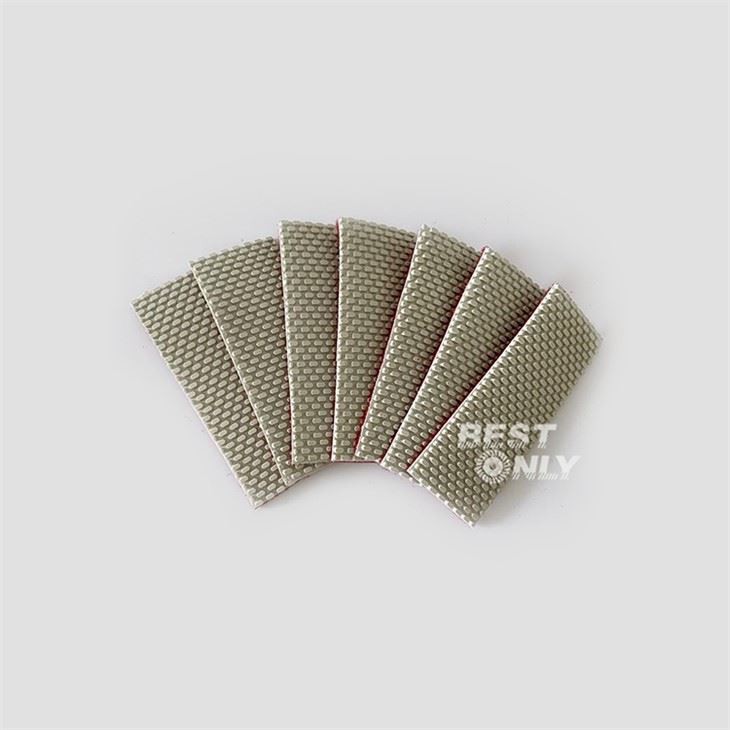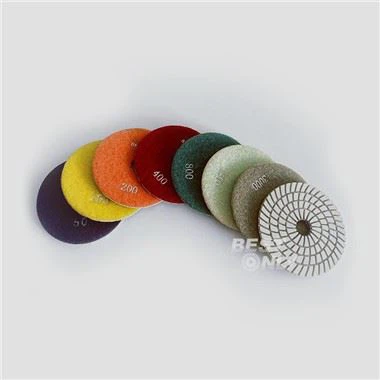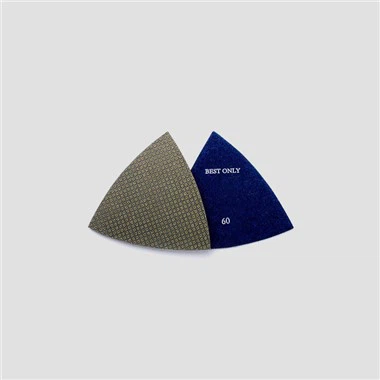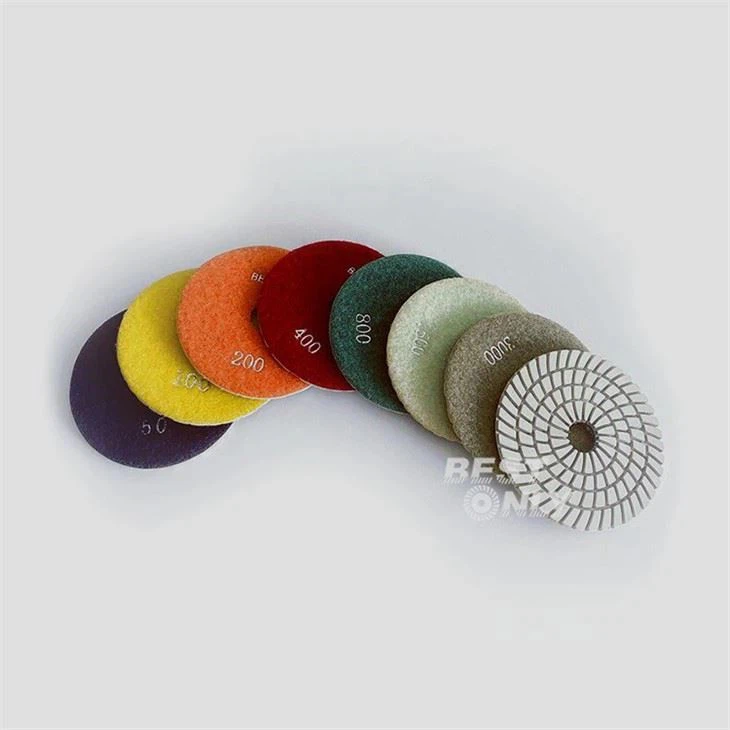
Marble Polishing Pads
We promise to provide you with the fastest reply, the best price, the best quality, and the most complete after-sales service.
Description
The Marble Polishing Pads pad is one of the most versatile diamond tools used in concrete/ marble polishing. They are vital in stone projects and are useful for rough grinding, honing, shaping, and polishing.
Benefits of Marble Polishing Pads
Superior Performance and Efficiency
When working with tough materials like stone and concrete, you need tools that are a symphony of strength and precision. Such materials have historically presented significant difficulties, even for seasoned experts. Even though conventional methods of stone polishing had their advantages, they frequently led to higher labour costs, longer project times, and inconsistent outcomes. Enter the modern marvels that have fundamentally altered this paradigm: diamond polishing pads and grinding discs.
Diamond Polishing Pads Exceptional Durability
For professionals who are deeply entrenched in the world of flooring, tool longevity isn't just a luxury; it's a necessity. While run-of-the-mill tools may quickly show signs of wear and tear, resulting in interruptions and escalated costs, diamond polishing pads have been designed to challenge and redefine these norms. Their impressive durability ensures they withstand the rigorous demands of their tasks, making them a sound investment for any flooring project.
Versatility in Application
Each material, whether a slab of granite or a stretch of concrete, presents its own set of challenges in the intricate world of flooring. As a result, the tools selected for the job must be extremely versatile. Diamond polishing pads stand as a beacon of adaptability in this regard. These pads are the ideal solution for everything from the rough surfaces of granite to the subdued elegance of marble to the intricate artistry in terrazzo.
Suitable for Residential and Commercial Use
The true testament to a tool's prowess lies in its ability to deliver consistently, irrespective of the project's scope. Diamond polishing pads pass this test with flying colours. Their unwavering performance, be it in an intimate residential setting or an expansive commercial establishment undergoing floor renovations, has earned them the trust of professionals worldwide. Contractors, therefore, have the confidence to promise their clientele an unparalleled finish, regardless of the project's scale.
Product Code:BL-SG
Specification:4''/ 5''' with thickness=2.5mm
Grit:50 /100 /200 /400 /800/ 1500 /3000 /BUFF
Recommeded RPM:2600-4500
Application:Wet using for granite and other hard stone Polishing
Product Code:BL-WSPA
Specification:3''/ 4''/ 5''/6'' with thickness=2.5mm
Grit:30/ 50 /100 /200 /400 /600/ 800/ 1000/1500 /3000 /6000
Recommeded RPM:3500-4500
Application:Wet & Dry using for Onyx Marbles & Quartz & Concrete&Granite Polishing
Product Code:BL-5SWP
Specification:3''/ 4''/ 5'' with thickness=2.5mm
Grit:0# 1# 2# 3# 4# 5#
Recommeded RPM:2600-4500
Application:Wet using for Granite & Marbles & Quartz & Concrete Polishing
Dry Diamond Polishing Pads Universal
Product Code:BL-DWH
Specification:3''/ 4''/ 5'' with thickness=2.5mm
Grit:50# 100# 200# 400# 800# 1500# 3000# Buff
Recommeded RPM:1000-5000
Application:For Granite & Marbles & Quartz & Concrete& Enginner Stone & Limestone Dry Polishing
Dry Polishing Pads For Hard Stone
Product Code:BL-DHPG
Specification:3''/ 4''/ 5''/6'' with thickness=2.2mm
Grit:50# 100# 200# 400# 800# 1500# 3000# Buff
Recommeded RPM:1000-5000
Application:For Hard Granite & Marbles & Quartz & Concrete Dry Polishing
3 Steps Granite Polishing Pads
Product Code:BL-3HGP
Specification:4''/ 5'' with thickness=3.0mm
Grit:0# 1# 2# 3#
Recommeded RPM:3500-4500
Application:For Granite & Other Hard Stones Wet Polishing
3 Steps Dry And Wet Polishing Pads
Product Code:BL-3WSP
Specification:3''/ 4''/ 5''/6'' with thickness=2.5mm
Grit:0# 1# 2# 3#
Recommeded RPM:3500-4500
Application:Wet & Dry using for Granite & Marbles & Quartz & Concrete Polishing
Model: BL-RSW
Size: 120x45x2mm/120x90x2mm/240x90x2mm
Grits: 50# 100# 200# 400# 800# 1500# 3000# buff
Application: Granites, Marble, Concrete, Quartz and Engineer Stones.
For Wet & Dry Polishing
Connection: Hook & Loop
V2 Electroplated Polishing Sheets
V2 Electroplated Polishing Sheets
Model Number: BL-DEHP
Brand:BEST ONLY
Product Name:Diamond ElectroplatedPolishing Pad
Size: 120/78*55mm
Material:Diamond+Electroplated
Origin:Xiamen ,China.
Why Choose Us
Our History
Xiamen Best Only Diamond Tools which is located in beautiful seaside City Xiamen was established in 2013. We are one of the best diamond tools suppliers in China. As our company name " BEST ONLY",
Product Application
Xiamen Best Only Diamond Tools products are widely used in the grinding andpolishing field of natural stone, sintered stone, engineer stone, ceramic, and concrete, etc.
Our Product
Our main products including Resin Diamond Polishing Pads, 3 Steps Diamond Polishing Pads, Dry Diamond Polishing Pads, Wet Diamond Polishing Pads, Metal Diamond Polishing Pads,Diamond Cup Wheels, Diamond Milling Wheels, Electroplated Diamond Polishing Pads, Diamond Polishing Belts, Diamond Polishing Sheets, Diamond Hand Polishing Pads, Diamond Core Bits, Diamond Brushes,Backing Pads, CNC Router Bits, Engraving Tools ,etc.
Production Market
With over 10 years diamond tools production and exporting experience, We are dedicated to providing you diamond tools with both competitive prices and high quality effectively. Our products are welcome in the market of Europe, North and South American, South-East Asia, Middle Asia, etc. Good reputation has won praise and trust from home and abroad.

Proper maintenance and care for diamond polishing pads are essential to ensure their longevity and optimal performance. By following these tips, you can prolong the lifespan of your pads and achieve the best results when polishing marble surfaces.
Clean after each use: After each polishing session, it is crucial to clean the diamond polishing pads thoroughly. Use a soft brush or compressed air to remove any residue or debris that may have accumulated on the pads. This will prevent the buildup of material that can affect the pad's performance.
Store properly: When not in use, store your diamond polishing pads in a clean and dry environment. Avoid placing heavy objects on top of the pads, as this can cause them to deform or lose their shape. Storing them properly will help maintain their integrity and prevent any damage.
Inspect for wear: Regularly inspect your diamond polishing pads for signs of wear or damage. Look for any uneven wear patterns, fraying edges, or loss of diamond particles. If you notice any of these issues, it may be time to replace the pads to ensure consistent and effective polishing.
Use with water: When using diamond polishing pads for marble, it is essential to use them with water. This helps to cool the pads and prevent them from overheating, which can lead to premature wear. Additionally, water helps to flush away debris and keep the surface lubricated for smoother polishing.
Follow recommended RPM: Different diamond polishing pads have specific RPM (rotations per minute) recommendations for optimal performance. Make sure to follow these guidelines and avoid exceeding the recommended RPM, as this can cause damage to the pads and compromise the quality of the polish.
By following these maintenance and care tips, you can ensure that your diamond polishing pads for marble remain in excellent condition and deliver exceptional results. Remember to clean, store, inspect, use with water, and adhere to the recommended RPM for the best performance and longevity of your pads.
What Are the Different Types of Polishing Pads
When it comes to polishing pad variety, there are a number of ways to examine that question. First, you could discuss the differences in their use. Or, you could look at the characteristics of each of the pads in a set. And there are even more angles you could take when comparing diamond polishing pads. What we will do in this article is consider a variety of ways that one could answer the question: "what are the different types of polishing pads?" Along the way, we will try to highlight some of the important variations between pads that are used by stone fabricators and installers.
A Difference In Quality
One of the first main variants when it comes to comparing the differences and similarities of polishing pads is the quality. However, there are a number of factors that can affect the quality of a diamond polishing pad. Let's take a look at just three such factors. Three factors that contribute to a polishing pad's quality are:
Kind of Resin Bond
Performance of the Diamonds
Flexibility of the Pad
Resin Bond
When it comes to the quality of bond that is used for a given diamond polishing pad, it is important to choose one appropriate for the task. The resin bond that is used for the polishing pad plays a role in the pad's performance. Why is that the case? Well, the resin must be strong enough to hold the diamonds so they can perform their function. Namely, the cutting of the stone surface.
Additionally, the bond must wear down at a particular rate. As the resin bond wears, it exposes diamonds that were not exposed previously. This process continues as the pad wears down; eventually reaching the end of its life. As you can imagine, the type of resin bond will impact the way the polishing pad wears, cuts, and lasts. As a result, a quality polishing pad will have a resin bond that performs best for the task it was made.
Diamond Quality
Diamonds are used in the stone industry because they are extremely hard. This means that they can cut rock. In fact, a stone's hardness is measured on the Mohs scale; a scale on which diamond registers at the highest level (10).
Not only is the quality of the diamonds used in the polishing pad important, but also the diamond concentration. This is due to the reason we just mentioned. Since the diamonds are what cuts the stone, then the quantity and quality of these has a direct impact on the polishing pad's performance.
Pad Flexibility
A polishing pad's flexibility can be exactly what is needed. And, at other times, it may not be what you are after. For example, if the pad is being used to polish edges that are curved, flexibility is exactly what the fabricator needs. Yet not all pads are flexible.
Other pads that are not flexible may be a good choice for polishing flat surfaces. Since many natural stones are comprised of various minerals, large flat surfaces will most likely vary in hardness. If you are polishing a large flat area with a polishing pad that is flexible your polishing pad's performance may not be as good as it could be.
Differences in Usage
As we have discussed, differences in the quality of the pads can be affected by various charactristics (or properties) of the pad. However, we also established that various attributes contribute to the way a polishing pad performs. This means that polishing pads can be designed to work well for specific uses.
Wet Diamond Polishing Pads
One type of use that polishing pads are designed for is wet polishing. Wet polishing pads are designed for use in a fabrication shop while water is being applied to the surface being polished. As you can imagine, high speed polishing with resin pads causes friction. This friction heats up the pad and the stone. Water is used to keep the temperature from climbing to a point that can hinder the polishing process.
Dry Diamond Polishing Pads
Although many polishing pads are used in a wet environment, there are others that get used in a dry environment. This is the case when a stone installer needs to touch up a stone that is all ready in a home. When stone professionals are working on a stone that is in a person's home, it is not practical to set up a wet environment in which to polish with wet pads. In these scenarios, the dry polishing pads are the solution.
Hand Polishing Pads
Still different from the other pads mentioned is the hand polishing pads. These pads work differently than the grinder polishing pads. Hand polishing pads do not fasten to a tool. Rather, they are held in the fabricator or installer's hand and used to touch up stone that get's nicked or scuffed from a tool that was used during the installation or fabrication process.
Some stone professionals prefer using diamond hand pads instead of angle grinder polishing pads. This makes sense in some cases, particularly in cases where the touch up is not large enough to warrant setting up a power tool to correct. As a result, diamond hand polishing pads are often times found on the truck of stone installation professionals.
Different Pads for Different Materials
Each type of stone that is being polished has very distinct traits. These traits determine which polishing pads will work better on the stone. Let's take a look at some scenarios that highlight this point.
Polishing Pads for Quartz
Enigneered stone brings with it some specific characteristics. One such characteristic is the fact that engineered stone contains resin. Engineered stone is also known as "quartz". The process consists of combining natural quartz materials with a little bit of resin to form a slab of material that can be referred to as natural stone. The presence of the resin though, means that polishing the stone will require a pad designed not to burn the resin. By using a polishing pad designed for polishing quartz materials or engineered stone, you save yourself extra work. Namely, having to correct issues that could arise during the polishing process.
Polishing Pads for Marble
Other materials that warrant a specific kind of polishing pad are stones that fall into the "soft" category. This category includes the following natural stone:
Marble
Limestone
Travertine
Onyx
These so-called "soft stones" can clog up some polishing pads during polishing. So, it might be wise to select a polishing pad that is designed to effectively polish these specific stone materials.

Step-by-Step Guide on Using Marble Polishing Pads
To achieve a professional and flawless finish on your marble surfaces, follow this step-by-step guide on using diamond polishing pads:
Preparation: Before you begin, make sure the marble surface is clean and free from any debris or dirt. Use a mild detergent and water to thoroughly clean the surface, and allow it to dry completely.
Choose the Right Grit: Diamond polishing pads come in various grit levels, ranging from coarse to fine. Start with a lower grit pad, such as 50 or 100, to remove any scratches or imperfections on the marble surface. Gradually work your way up to higher grit pads, such as 200, 400, and so on, for a smoother and more polished finish.
Attach the Pad: Attach the diamond polishing pad to a handheld polisher or a floor buffer, depending on the size of the marble surface. Make sure the pad is securely attached and centered on the machine.
Wet Polishing: Wet the marble surface with water to create a lubricating film. This helps to prevent heat and friction during the polishing process. Start with the lowest grit pad and move the polisher in a circular motion, applying even pressure. Continue polishing until you achieve the desired level of smoothness and shine.
Progressive Polishing: As you move up to higher grit pads, repeat the same circular motion, gradually increasing the speed of the polisher. This will further refine the surface and enhance its luster. Make sure to clean the surface and change the water between each grit level to remove any residue.
Finishing Touches: Once you have reached the highest grit pad, the marble surface should have a glossy and reflective finish. If desired, you can apply a marble sealer to protect the surface and enhance its longevity.
Remember to always follow the manufacturer's instructions and guidelines when using diamond polishing pads. With proper technique and care, you can achieve professional-grade results and restore the natural beauty of your marble surfaces.
How to Choose the Marble Polishing Pads
Consider these factors when purchasing buffing pads:
Material: Buffing pads are made from various materials. Consider how the pad will be used and against what surface to decide the best material.
Flexibility: You may need more or less flexibility in your buffing pads depending on the curves and edges of the surface you want to use the product on. A flat surface is suitable for rigid pads, but the surface of your vehicle requires a pad with flexibility.
Cut: The cut of a pad refers to how it removes defects. Aggressive pads can remove deep scratches and imperfections in paint quickly, while a less aggressive pad requires more buffing time and leaves a smoother finish. If you use buffing pads to wax, then you need a pad with no cut so that it is not too rough on the surface.
Surface paint: Consider the paint on the surface you're going to be using the buffing pad against. There are different buffing pads that manufacturers recommend using for clear coats, dark paint, etc.
Surface size: Consider the size of the surface you wish to use the buffing pads on. This can help determine the diameter of the pad you should buy. If you use a sander or polisher, the pad needs to be slightly larger to fit your tool properly.
Buffing machine: If you already have a power tool for buffing, such as a sander, ensure that the buffing pads are compatible. It's also important that the buffing pads come with a backing pad to attach the pads to the polisher or sander.
Warranty: You may want a buffing pad with a warranty included by the manufacturer. This may help guarantee the quality of the buffing pads and protect you if the product is faulty.

Why polishing pads matter
Efficient Paint Correction
Polishing pads serve as the frontline soldiers in the battle against imperfections. When paired with a suitable polishing compound, they efficiently remove swirl marks, scratches, and oxidation, unveiling a vibrant and flawless paint finish.
Versatility In Application
The beauty of polishing pads lies in their adaptability. From cutting pads designed for heavy correction to finishing pads for the final touch, there's a pad tailored to every detailing need. This versatility extends beyond automobiles, making them indispensable for various surfaces like glass, plastic, and metal.
Time And Effort Savings
Gone are the days of manual labor-intensive polishing. In tandem with high-quality machines, polishing pads significantly reduce the time and effort required to achieve professional-level results. This not only enhances efficiency but also makes the detailing process more accessible for enthusiasts.
Long-Term Surface Protection
Polishing pads contribute to more than just aesthetic improvements. By creating a smoother surface, they act as a barrier against dirt and contaminants. This not only preserves the paint's integrity but also ensures long-term protection, extending the life of the surface being treated.
Our Factory
With over 10 years diamond tools production and exporting experience, We are dedicated to providing you diamond tools with both competitive prices and high quality effectively. Our products are welcome in the market of Europe, North and South American, South-East Asia, Middle Asia, etc. Good reputation has won praise and trust from home and abroad.

FAQ
Q: How do I know which polishing pad to use?
Best pad for the particular application
Ideal machines for the pads
Q: What is the difference between a buffing pad and a polishing pad?
Q: Should polishing pad be wet or dry?
Q: How many times can you use a polishing pad?
Q: What grit is best for polishing marble?
Q: What is the best rpm for polishing marble?
Q: How many days does it take to polish marble?
Q: How do you polish marble hacks?
Q: What are the different levels of polishing pads?
Q: How often should you change buffing pads?
Q: Should I wet my polishing pad?
Q: Is a buffing pad the same as a polishing pad?
Q: Why do some polishing pads have holes?
Q: How do you polish marble to high gloss finish?
Q: Which chemical is used for marble polishing?
Q: Do you have to seal marble after polishing?
Q: Is it hard to polish marble?
Q: Should you polish marble wet or dry?
Q: What grit is used to polish marble?
Q: How do you use diamond polishing pads on marble?
Hot Tags: marble polishing pads, China marble polishing pads suppliers, manufacturers, factory, , , ,








